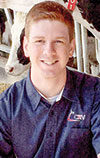Today, a grazing dairy operation is not just a small farm with a handful of cows on a hillside. In fact, the definition of grazing has evolved – and all grass-based operations can fall under different categories.
Producers all over the country are finding a wide variety of ways to graze cattle – cattle that come in all shapes, sizes and colors. And there are operations that range from a few cows to several thousand cows, all with different nutrition approaches and living in different climates.
No matter what the breed or location is, there are many reasons to graze, and no one way of grazing dominates another. Each is distinct and good in their own way as long as there is the right land available, and the producer has the right plan, the right genetics and a clear vision for his or her operation. And despite all the possible dairying differences, every grass-based producer hopes to build a herd that is healthy and most efficiently converts grass to milk.
Grazing is more complicated than some think; it’s much more than letting the cows out to pasture. It is a true science that includes evaluating genetics, forage selection and management strategies. Managing each well can improve efficiency and, hopefully, profitability, and the easiest to manage is the herd’s genetics.
Because you can see progression in a relatively quick period, producers should take advantage of the right cattle genetics that are best for their individual herd – based on their specific needs and situation. Dairy genetics companies around the world have varying expertise in grazing genetics, and each has a variety of solutions to help grass-based operations succeed. No matter what organization producers purchase their genetics from, producers should work closely with their genetics team to develop customized solutions for their specific operation – and the opportunities to build an ideal herd are endless.
Healthy, efficient, profitable grazing herds
The right use of genetics will help producers build a herd to drive efficient production, build healthier herds and produce premium milk – leading them to their ideal grazing cow. The ideal grazing cow can produce a lot of milk with a small amount of grass and make efficient use of your pastures. The biggest thing to look for in genetics is efficiency: the highest conversion from grass to protein to better position the marketability of your milk.
Not only should genetics help you remain profitable through your milk check but to also help create trouble-free cows that can withstand the climate in pastures all over the world. Each cow needs to be bred to have exceptional bone structure, allowing them to walk back and forth to pasture with ease. Ideal cows must have tremendous capacity to consume forages. A grazing operation desires great fertility to get bred easily and calve each year. And one of the most important traits graziers want are cows with well-attached udders that can produce the high-component, premium milk efficiently.
One option to help build the ideal cow is the use of crossbreeding. Too often, farmers are grazing or crossbreeding with cows that have been bred for many years to produce milk from a TMR. Cows that efficiently convert TMR to milk are not the same cows that will maximize grass. Therefore, graziers must look to genetics that provide a true grazing bull lineup because one size does not fit all when it comes to genetics. Also, crossbreeding genetics can help breed cows better adept at surviving different climates all over the world.
Climate should also be a factor when looking for breeds to incorporate into your system. While New Zealand breeds are extremely efficient producers, the climate of New Zealand doesn’t match much of the northern U.S. European breeds are more adaptable to winter climates but also may require supplemental feeds to reach desired production levels. Therefore, crossbreeding can help a producer find their balanced cow that can efficiently produce milk while grazing and in the winter months when grazing is limited or not available. Crossbreeding truly allows for the benefits of two breeds to come together to produce an easy-to-manage cow.
Nearly every dairy breed has been used on grass-based operations, and each breed has its strengths and weaknesses – but there are a few breeds that rise above the rest when it comes down to the ideal grazing cow. Each of the following breeds have their strengths associated that can help your herd based on your needs and goals (Table 1).
Click on the image above to view a larger image.
Each breed has beneficial characteristics, but when looking at any breed to bring on your grazing operation, make sure to focus on the following traits: High component percentages, longevity, udder composite, foot and leg structure, hoof health and body capacity.
There are many different variations of grazing cattle, and each operation can be unique – unique systems require unique cows. But each grazing dairyman has the same overarching goal: to breed efficient cattle to obtain the highest efficiency of feed converted to milk. Therefore, every grazing farmer should turn to genetics to optimize his herd for efficiency and profitability. These genetics will allow producers to have an easy-to-manage herd by driving efficient production, building healthier herds and producing premium milk. ![]()
Elizabeth Sarbacker is a CRV USA marketing and communications intern.

-
Matthew Costello
- Grazing Product Manager and Midwest Area Sales Manager
- CRV USA
- Email Matthew Costello
PHOTO: Incorporating breeds like New Zealand Friesian into a grazing herd can offer advantages in fertility, milk solids and feed efficiency. Photo courtesy of CRV USA and Milton Marketing Co.






